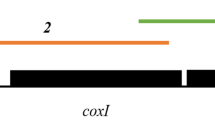Abstract
The ovine maedi-visna virus (MVV) and caprine arthritis-encephalitis virus (CAEV) are small ruminant lentiviruses (SRLVs) with striking genetic and structural similarities. The presence of SRLV in Mongolian sheep and goats was serologically demonstrated more than a decade ago; however, the viral genotype remains unknown. In total, 329 blood samples were collected from two sheep breeds (i.e., Khalkha and Sumber) in Tov, Govisumber, Arkhangay, Dornogovi, Zavkhan, and Sukhbaatar provinces, Mongolia. Serological and phylogenetic analyses were performed regardless of any apparent clinical signs, although most of the animals appeared healthy. All sheep in three of the six provinces were seronegative, whereas the seroprevalence in the Tov, Govisumber, and Zavkhan provinces averaged 7.9%. Genomic DNA from seropositive animals was tested using hemi-nested polymerase chain reaction, and sub-genomic SRLV sequences were determined from nine samples. Mongolian SRLV sequences clustered within the divergent subtype A22, which was previously found only in Fertile Crescent regions, including Lebanon, Jordan, and Iran, where the first sheep-domestication (Ovis aries) occurred. According to the phylogenetic analysis, genotype A has two ancestors from the ancient Fertile Crescent: (1) Turkish strains and (2) Iranian, Jordanian, and Lebanese strains. The first ancestor spread westward, whereas the second spread eastward, ultimately reaching Mongolia.


Similar content being viewed by others
Data availability
No datasets were generated or analysed during the current study.
References
Alberto FJ, Boyer F, Orozco-Terwengel P et al (2018) Convergent genomic signatures of domestication in sheep and goats. Nat Commun 9. https://doi.org/10.1038/s41467-018-03206-y
Arcangeli C, Torricelli M, Sebastiani C et al (2022) Genetic characterization of small ruminant lentiviruses (SRLVs) circulating in naturally infected sheep in Central Italy. Viruses. https://doi.org/10.3390/v14040686
Bertolotti L, Mazzei M, Puggioni G et al (2011) Characterization of new small ruminant lentivirus subtype B3 suggests animal trade within the mediterranean basin. J Gen Virol 92. https://doi.org/10.1099/vir.0.032334-0
Brinkhof JMA, Houwers DJ, Moll L et al (2010) Diagnostic performance of ELISA and PCR in identifying SRLV-infected sheep and goats using serum, plasma and milk samples and in early detection of infection in dairy flocks through bulk milk testing. Vet Microbiol. https://doi.org/10.1016/j.vetmic.2009.09.060
Carrozza ML, Niewiadomska AM, Mazzei M et al (2023) Emergence and pandemic spread of small ruminant lentiviruses. Virus Evol 9. https://doi.org/10.1093/ve/vead005
Chessa B, Pereira F, Arnaud F et al (2009) Revealing the history of sheep domestication using retrovirus integrations. Science (80-) 324. https://doi.org/10.1126/science.1170587
De Andrés D, Klein D, Watt NJ et al (2005) Diagnostic tests for small ruminant lentiviruses. Vet Microbiol. https://doi.org/10.1016/j.vetmic.2005.01.012
Giammarioli M, Bazzucchi M, Puggioni G et al (2011) Phylogenetic analysis of small ruminant lentivirus (SRLV) in Italian flocks reveals the existence of novel genetic subtypes. Virus Genes 43. https://doi.org/10.1007/s11262-011-0653-1
Gifford RJ (2012) Viral evolution in deep time: lentiviruses and mammals. Trends Genet 28(2):89–100. https://doi.org/10.1016/j.tig.2011.11.003
Gjerset B, Storset AK, Rimstad E (2006) Genetic diversity of small-ruminant lentiviruses: characterization of Norwegian isolates of caprine arthritis encephalitis virus. J Gen Virol 87. https://doi.org/10.1099/vir.0.81201-0
Grego E, Bertolotti L, Quasso A et al (2007) Genetic characterization of small ruminant lentivirus in Italian mixed flocks: evidence for a novel genotype circulating in a local goat population. J Gen Virol 88. https://doi.org/10.1099/vir.0.83292-0
Hall TA (1999) BIOEDIT: a user-friendly biological sequence alignment editor and analysis program for windows 95/98/ NT. Nucleic acids Symp Ser 41:
Herrmann-Hoesing LM (2010) Diagnostic assays used to control small ruminant lentiviruses. J Vet Diagnostic Investig. https://doi.org/10.1177/104063871002200602
Kuhar U, Barlič-Maganja D, Grom J (2013) Phylogenetic analysis of small ruminant lentiviruses detected in Slovenia. Vet Microbiol 162. https://doi.org/10.1016/j.vetmic.2012.08.024
Kumar S, Stecher G, Tamura K (2016) MEGA7: molecular evolutionary genetics analysis version 7.0 for bigger datasets. Mol Biol Evol 33(7). https://doi.org/10.1093/molbev/msw054
L’Homme Y, Leboeuf A, Arsenault J, Fras M (2015) Identification and characterization of an emerging small ruminant lentivirus circulating recombinant form (CRF). Virology. https://doi.org/10.1016/j.virol.2014.11.006
Lindqvist A (2001) Animal health and welfare in organic sheep and goat farming–experiences and reflections from a Swedish outlook. Acta Vet Scand Suppl 95:27–31
Lv FH, Peng WF, Yang J et al (2015) Mitogenomic meta-analysis identifies two phases of migration in the history of eastern Eurasian sheep. Mol Biol Evol 32. https://doi.org/10.1093/molbev/msv139
Machová K, Málková A, Vostrý L (2022) Sheep post-domestication expansion in the context of mitochondrial and Y chromosome haplogroups and haplotypes. Genes 13(4):613. https://doi.org/10.3390/genes13040613
Michiels R, Adjadj NR, De Regge N (2020) Phylogenetic analysis of belgian small ruminant lentiviruses supports cross species virus transmission and identifies new subtype B5 strains. Pathogens. https://doi.org/10.3390/pathogens9030183
Molaee V, Bazzucchi M, De Mia GM, et al (2020) Phylogenetic analysis of small ruminant lentiviruses in Germany and Iran suggests their expansion with domestic sheep. Sci Rep 10. https://doi.org/10.1038/s41598-020-58990-9
Muz D, Oǧuzoǧlu TÇ, Rosati S et al (2013) First molecular characterization of visna/maedi viruses from naturally infected sheep in Turkey. Arch Virol 158. https://doi.org/10.1007/s00705-012-1518-1
Nansalmaa M, Serchmaa T, Odonchimeg M et al (2012) Seroprevalence studies for Brucellosis and other animal infectious diseases. In: State Central Veterinary Laboratory Proceedings. Ulaanbaatar, Mongolia, pp 46–57 (in Mongolian)
Nei M, Kumar S (2000) Molecular evolution and Phylogenetics. Oxford University, Oxford
Olech M, Kycko A, Kuźmak J (2022) Molecular characterization of small ruminant lentiviruses isolated from polish goats with arthritis. Viruses 14. https://doi.org/10.3390/v14040735
Peterhans E, Greenland T, Badiola J, Harkiss G, Bertoni G, Amorena B, Eliaszewicz M, Juste RA, Krassnig R, Lafont JP, Lenihan P, Pétursson G, Pritchard G, Thorley J, Vitu C, Mornex JF, Pépin M (2004) Routes of transmission and consequences of small ruminant lentiviruses (SRLVs) infection and eradication schemes. Vet Res 35(3):257–274. https://doi.org/10.1051/vetres:2004014
Reina R, Bertolotti L, Dei Giudici S et al (2010) Small ruminant lentivirus genotype E is widespread in Sarda goat. Vet Microbiol 144. https://doi.org/10.1016/j.vetmic.2009.12.020
Ryder ML (1984) Sheep. In: Mason IL (ed) Evolution of domesticated animals. Longman, New York, pp 63–84
Santry LA, de Jong J, Gold AC et al (2013) Genetic characterization of small ruminant lentiviruses circulating in naturally infected sheep and goats in Ontario, Canada. Virus Res. https://doi.org/10.1016/j.virusres.2013.03.019
Shah C, Böni J, Huder JB et al (2004) Phylogenetic analysis and reclassification of caprine and ovine lentiviruses based on 104 new isolates: evidence for regular sheep-to-goat transmission and worldwide propagation through livestock trade. Virology 319. https://doi.org/10.1016/j.virol.2003.09.047
Sigurdsson B, Grímsson H, Pálsson P (1952) Maedi, a chronic, progressive infection of sheep’s lungs. J Infect Dis 90. https://doi.org/10.1093/infdis/90.3.233
Staskus KA, Retzel EF, Lewis ED et al (1991) Isolation of replication-competent molecular clones of visna virus. Virology 181. https://doi.org/10.1016/0042-6822(91)90488-W
Straub OC (2004) Maedi - Visna virus infection in sheep. History and present knowledge. Comp Immunol Microbiol Infect Dis 27. https://doi.org/10.1016/S0147-9571(02)00078-4
Tamura K, Nei M (1993) Estimation of the number of nucleotide substitutions in the control region of mitochondrial DNA in humans and chimpanzees. Mol Biol Evol 10. https://doi.org/10.1093/oxfordjournals.molbev.a040023
Acknowledgments
The authors thank all the veterinarians of the Tov, Zavkhan, and Govisumber provinces, the State Breeding Agency of Govisumber province, and former veterinary students Tserennadmid Lhagva, Nyamgarav Baasanjav, and Naranzul Enkhtur for their kind help.
Funding
This work was supported mainly by the “Project for Strengthening the Practical Capacity of Public and Private Veterinarians” MJ-Vet project A02 supported by the Japan International Cooperation Agency (JICA), and partially by the Science & Technology Foundation (STF) of Mongolia.
Author information
Authors and Affiliations
Contributions
Conceived of or designed study: DN, ST; Performed the investigation and data validation: DN, SG, NG, MM, YS; Analysed data: DN, ST, VM, TE, GL; Wrote the original manuscript, and revised the paper: ST, DN, GL, VM.
Corresponding author
Ethics declarations
Ethics approval
All the procedures involving animals were done in compliance with animal welfare and ethical guidelines provided by the Ethical Committee of the Veterinary Science and Bio-medical Research (permit, ref.: VSBMR23/01/24) at the Mongolian University of Life Sciences.
Competing interests
The authors declare no competing interests.
Additional information
Publisher’s Note
Springer Nature remains neutral with regard to jurisdictional claims in published maps and institutional affiliations.
Rights and permissions
Springer Nature or its licensor (e.g. a society or other partner) holds exclusive rights to this article under a publishing agreement with the author(s) or other rightsholder(s); author self-archiving of the accepted manuscript version of this article is solely governed by the terms of such publishing agreement and applicable law.
About this article
Cite this article
Davaasuren, N., Molaee, V., Erdene-Ochir, TO. et al. Phylogenetic analysis of small ruminant lentiviruses in Mongolian sheep supports an ancient east-west split for the genotype A. Vet Res Commun 48, 1955–1962 (2024). https://doi.org/10.1007/s11259-024-10361-9
Received:
Accepted:
Published:
Issue Date:
DOI: https://doi.org/10.1007/s11259-024-10361-9




